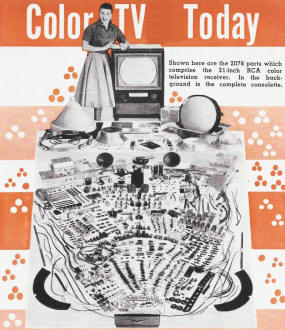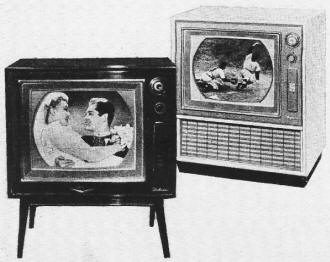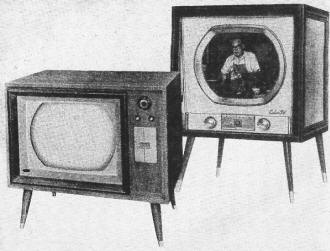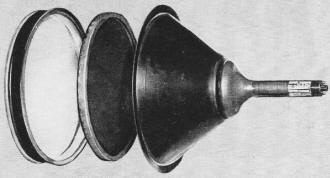|
By 1955, two years
after the official adoption of the NTSC (National Television System Committee ) standard for commercial color
television broadcasts and just one year since the first sets were put on sale,
the industry was concerned that "only" 30,000 color TVs had been sold. That
seems like a pretty good number to me given that the
median family income was $4,400 per year ($42.5k
in 2020 dollars) in 1955. With an initial $1,000 price
tag ($9.7k
in 2020 - the cost of 10 iPhone 11 Pro's) for a 12" set that represented nearly a quarter of a year's pay.
Black & white (B&W) TV sets ran around $200-300. One of the cost-adders for
color TVs was the requirement to be backward compatible with B&W broadcast
signals. 25 to 30 vacuum tubes were needed to handle all the signal
demodulation, processing, and presentation. Prices started dropping pretty
quickly as more manufacturers came online and competition kicked in.
Cathode ray tubes (CRT's) were the biggest expense, so improving processes
and materials made a huge impact in lowering costs. In fact, by the time this
article was published in the December issue of Radio & Television News
magazine, 21" color CRT's were common and set prices had fallen to $800 - still
expensive but a better value that $1k for a 12" tube.
Color TV Today

Shown here are the 2076 parts which comprise the 21-inch RCA
color television receiver. In the background is the complete consolette.
More color-telecasting and greater production of color TV receivers
promised in 1956, but how do we stand today?
By Milton S. Kiver*
The subject of color television, brought up in any gathering of engineers or
laymen, always evokes considerable comment. Yet in spite of this obvious interest,
and in spite of the fact that we live in an age of production miracles, color television
receivers have appeared only in token quantities. It has been estimated that the
public owns no more than 30,000 such receivers - this fully two years after the
FCC gave its official blessing to the NTSC compatible color television system and
after set manufacturers have initiated extensive sales campaigns and exhibited numerous
models.
What has been happening to color and what are the reasons behind the limited
distribution of sets? The initial sets, which appeared in 1954, employed 12-inch
picture tubes and were priced somewhere in the neighborhood of $1000. Today we have
21-inch color picture tubes and a lot fewer tubes in the receiver and the average
price tag is around $800. From one point of view, the enlargement of the picture
tube from 12 to 21 inches can be considered as excellent progress. The rub, however,
lies in the $800 price tag; this is still far from the range where extensive customer
buying will take place.
The Price Factor
Black-and-white television receivers, of good quality, can be purchased for between
$200 and $300. Furthermore, well over 95 per-cent of all of today's programming
is in black-and-white, so the inducement to purchase a color set is further reduced.
Industry spokesmen are pretty well agreed that with more color programs and cheaper
color sets, the public would buy and in substantial quantity. Of these two factors,
it is the price of the color set which is perhaps the most important.
Present color television receivers have between 26 and 28 tubes. This is not
an excessive number when compared to black-and-white receivers and so only a small
part of the higher cost of a color receiver is due to the number of its tubes and
to the additional complexity of its circuits. The rest of the answer, then, must
be found in one other place: the picture tube. This is a 3-gun affair with a fairly
intricate shadow mask and phosphor screen arrangement, and the production expenses
are such that the tube costs the receiver manufacturer around $125. When normal
handling and distribution costs are added to this, the price to the customer is
in the neighborhood of $250 or more. If we compare this cost with that which a set
manufacturer pays for a comparable black-and-white picture tube (about $18), some
of the reasons for the present high cost of color television receivers becomes understandable.
The obvious solution, of course, is to design a lower cost tube. Some of the
finest research engineers have been working on this problem for several years and
the present 21-inch tri-gun color tube is the best they have been able to produce.
Several manufacturers are known to be working on one-gun color picture tubes, but
thus far they have apparently not been able to produce a tube which can offer any
serious competition to the 3-gun tube. The single-gun Lawrence tube, a product of
the Chromatic Television Laboratories, has made several public appearances but thus
far the industry has not been able to develop much enthusiasm for it. At one time
Crosley announced that it was setting up a complete plant to manufacture this particular
tube, but for some unpublicized reason, the project was dropped.

Some commercial large screen color TV sets available now.

Represented are models by RCA, Magnavox, Sparton, and Motorola.
While progress in producing a large-screen, low-cost picture tube has been at
a snail's pace, the advance on the circuit front has been quite spectacular. The
number of tubes in the first color receiver was close to 40. Then the RCA license
laboratory came out with a 28-tube design that produced a good color picture. More
recently, the receiver division of RCA has further modified this circuit so that
only 26 tubes are needed and that is where the situation stands at present. (It
may be that the number of tubes will be reduced further to 23 or 24, but this is
not too significant. The true objective is not tube reduction per se, but tube reduction
without impairment of quality. From all present indications, we are close to the
point where quality may be threatened unless special type multipurpose tubes are
developed and made available soon.)
All of the new receivers show a trend to R-Y, B-Y or narrow-band color systems.
This is in contrast to I, Q receivers where the full color capabilities of the transmitted
signal are utilized. The underlying reason for this shift is tied in solely with
economics. The narrow-band receivers are cheaper to build. If the color pictures
produced by both systems are compared side by side, then the lack of color fidelity
of R-Y, B-Y sets becomes noticeable. However, from a practical standpoint, such
comparison tests are never made in the home and the color picture of a narrow-band
system proves satisfactory. It may be that when other costs, such as the tube, for
example, become more manageable, that more I, Q sets will be built. But as of now,
narrow-band sets predominate.
Those readers who have been fortunate enough to view color broadcasts on a well
designed and properly adjusted color receiver (using either system) can understand
why so much money and effort are being expended to evolve an economical commercial
receiver. Here is not just another "gimmick" designed solely to spur sales with
no real, intrinsic value behind it. On the contrary, here is something which, when
added to a television picture, greatly enhances the viewer's enjoyment of that image.
Perhaps the basic appeal of a colored image lies in its greater naturalness. We
live in an environment that contains many varieties of color and to desire the same
life-like qualities in television is quite understandable. Furthermore, color in
an image heightens the contrast between elements, brightens the highlights, deepens
the shadows, and appears to add a third dimension to an otherwise flat reproduction.
It is interesting to note that more detail appears to be present in colored images
containing fewer lines than corresponding black-and-white pictures. These remarkable
differences are apparent between color motion films and ordinary motion pictures.
Similar differences are observed with television.
Color Set Controls
Operation of a color television receiver by the average set user is not much
more difficult than operation of a black-and-white receiver. The familiar controls
of station selector, fine tuning, brightness, contrast, "on-off" switch, and volume
are used in color receivers, performing the same functions they do in monochrome
receivers. In addition, vertical and horizontal hold controls and perhaps a focus
control may be hidden behind a hinged front plate. Again, function remains unaltered
because essentially similar circuits are being employed in both types of receivers.
Two new controls that the set user will encounter in a color receiver stem
directly from the presence of color in the image. One control is called "color
intensity" and the other is "color shading." (Alternate names for these two
controls are "chroma" and "hue.") The color intensity or chroma control
regulates the amount of color signal reaching the screen and hence determines
the saturation with which colors are seen. In action it may be compared to the
familiar contrast control; note, however, that there is usually a master
contrast control that regulates the intensity of both the monochrome and color
portions of the image simultaneously. The chroma control might be considered as
an adjunct to this master contrast control, concerned only with the color
portion of the picture. The color shading, hue, or color fidelity control
enables the viewer, within a limited range, to alter colors observed on the
screen. As the control is rotated, red may change to yellow, green to blue, and
blue to magenta or red. If the various color circuits in the receiver are
functioning normally, then some point should be found over the range of this
control where the observed colors possess the proper hue. Probably the best
reference to use is the color of a person's skin. In the absence of this
reference, any familiar object, such as a yellow banana or a red apple, may be
employed.
The one precaution that must be carefully observed is in the adjustment of the
fine-tuning control. The importance of adjusting this control correctly must be
fully impressed upon the lay set user because it frequently takes no more than a
5 to 10 degree rotation of this control from its proper setting to kill the color
in the picture. The technical reason for this behavior stems from the fact that
the single most important segment of an incoming color signal is the color sync
burst, and incorrect positioning of the fine-tuning control can cause enough sync
burst attenuation to prevent opening up of the chrominance sections of the receiver:
result - no color, only black and white.
Typical of the tuning instructions which come with a color receiver are the following.
As a first step, tune in the signal just as for a black-and-white broadcast. Then
advance the color saturation control approximately two-thirds from its maximum counter-clockwise
position. Then carefully advance the fine-tuning control clockwise until the picture
just begins to disappear; next, turn counterclockwise slowly to the position where
the sound bars just disappear and color is in the picture. The final two steps then
involve touch up adjustments of the color saturation and hue controls for pleasing
color.
The year 1955 is drawing to a close and the production of color receivers has
been anything but spectacular. For the coming year, 1956, most receiver manufacturers
are cautiously optimistic. * All foresee increasing production and a continuing
trend toward lower prices. But very few will go on record either to estimate their
own production, or how much lower the prices will be, or even how fast they will
descend. A lot depends on the price of the color picture tube. At the moment, the
prices of existing receivers range from $695 on up. The lower figure is for the
Motorola Model 19CT1 which possesses 28 tubes and uses the CBS-Hytron "205" color
tube (a 19-inch screen). The circuit is essentially the same as that described in
the January and February, 1955 issues of Radio & Television News.

Exploded view of the RCA 21AXP22 three-gun color picture tube
in actual production at the present time. This tube uses a spherical shadow mask
and a metal envelope.
Many manufacturers will market either the RCA 26-tube receiver described in the
March, 1955 issue or modified versions of it. RCA has the receiver available in
two models: the "Director" (Model 21CT-662) in an open-face console for $895 and
the "Seville" (Model 21CT-661) in a low-boy consolette for a nationally-advertised
price of $795.
An interesting development that closely parallels a situation that existed in
black-and-white television in 1946 is the statement by Magnavox officials that RCA
will produce Magnavox's first color receivers. (At that time, RCA "private-labeled"
the 630 for a number of manufacturers.) Since volume production is not expected,
Magnavox feels that by using the existing facilities at RCA, a greater savings be
achieved than if Magnavox itself undertook to produce these first sets. Furthermore,
arrangements have been made with the RCA Service Company to service all such receivers
made for Magnavox on the same basis as for RCA color sets. This arrangement will
continue until Magnavox dealers can be provided with the necessary expertly-trained
service personnel.
Although Magnavox is the only company that has publicly announced such a policy,
it is known that other companies are considering a similar arrangement. This solution
offers an easy entree into the color television field until such time as sales warrant
full scale production for the smaller companies.
There are some manufacturers, like Zenith and Du Mont, who state quite definitely
that they do not feel color television receivers are ready for mass production at
this time. In the words of Leonard C. Truesdell, Zenith vice-president in charge
of sales, "We do not plan to mass produce color television receivers this year (1955).
Our engineering and development work is going forward at full speed, but it is our
opinion that color television receivers and especially color tubes are not ready
for mass production or for mass distribution."
Philco has announced that it is going ahead with the. production of a color receiver
using the 3-gun color tube. In view of the known fact that Philco is working on
a 1-gun tube, the inference can be drawn that enough progress has not been made
on this tube to warrant a competitive commercial receiver at this time. In the future,
perhaps 1956 or 1957, a low-cost 1-gun tube may be developed and then the over-all
picture can change significantly.
Andrea, Bendix, Packard-Bell, Hoffman, Emerson, and several other manufacturers
have definitely announced color sets containing from 26 to 28 tubes and priced from
$700 to $900. If any appreciable sales develop, the rush to climb aboard the bandwagon
will spread like fire in a dry forest.
Servicing
Now a word to the service industry. The arrival of color receivers in quantity
will certainly increase yearly volume by a considerable amount. But to adequately
take care of this new business, the individual service technician will have to do
two things: familiarize himself with color television fundamentals and add to his
present complement of service instruments. Of prime importance to color receiver
repair is the color-bar generator. This is an instrument which develops color signals
for use in the servicing and alignment of color receivers. In service, for example,
a color-bar generator can be put to a variety of uses, from an evaluation of the
over-all behavior and color fidelity of a receiver to a stage-by-stage analysis
of either the luminance or chrominance sections. In adjustment and alignment, use
of a known color signal quickly enables the technician to determine whether a circuit
or section is in adjustment and, if not, when this condition is attained in subsequent
alignment.
The next question, of course, is: "How much will these new generators cost?"
There are a number of color-bar generators presently available and all of these
fall into one of two categories. There are those generators which will develop test
signals that conform to the NTSC. (National Television Systems Committee) standards
for color signals. Into this group would go such generators as the Hickok Model
655XC, the Jackson Models 710 and 712, and the Hycon Model 616 color-bar generators.
These units offer extensive test facilities and range in price from $250 to $600.
Then there is a group of color-bar generators which will develop color patterns
on a receiver screen, but the signals they produce do not conform to NTSC standards.
This latter group of instruments is frequently called "rainbow" generators because
the colors they develop range in sequence from one end of the spectrum to the other.
Into this category fall such instruments as the Wintronix Model 150, the RCA Model
WR-61A generator, and the Triplett Model 3439. Prices in this group range from $50
to several hundred dollars.
Also important to the well-equipped service shop is a white-dot generator (for
picture tube convergence adjustments) and a wide-band oscilloscope (for inspection
of the color video signal, particularly the 3.58 mc. color burst.) White-dot generators
may be purchased separately (average price about $100) or may be obtained as part
of the color-bar generator. Wide-band oscilloscopes, with vertical system responses
to 4 mc. and above, are more expensive items, starting around $200 and ranging up
to $500 or more.
In short, the service technician will have to spend between $350 and $900 to
equip himself with the additional instruments required to adequately repair color
television receivers. To forego these expenditures is to ignore progress, a course
of action without a future.
In spite of the limited production that has been realized to date, the entire
industry foresees a rosy future for color television. In a recent speech, Paul V.
Galvin, president and chairman of Motorola, predicted that by 1965 there will be
65 million TV sets in use, of which more than half will be color sets. If .this
prediction does come true, . the immediate years ahead will indeed be busy ones.
.
* Author of "Color Television Fundamentals." McGraw-Hill Book Company, Inc.
* Information in this section was obtained from private sources and from answers
to a questionnaire that was sent to a number of receiver manufacturers. Responses
to the questionnaire were received from the following set manufacturers (in alphabetical
order): Andrea, Bendix, Crosley, Emerson, Hoffman, Magnavox, Motorola, Packard-Bell,
Philco, RCA, and Zenith. The author and the editors of Radio & Television News
would like to express their thanks to these firms for their cooperation
Posted September 2, 2020
|













